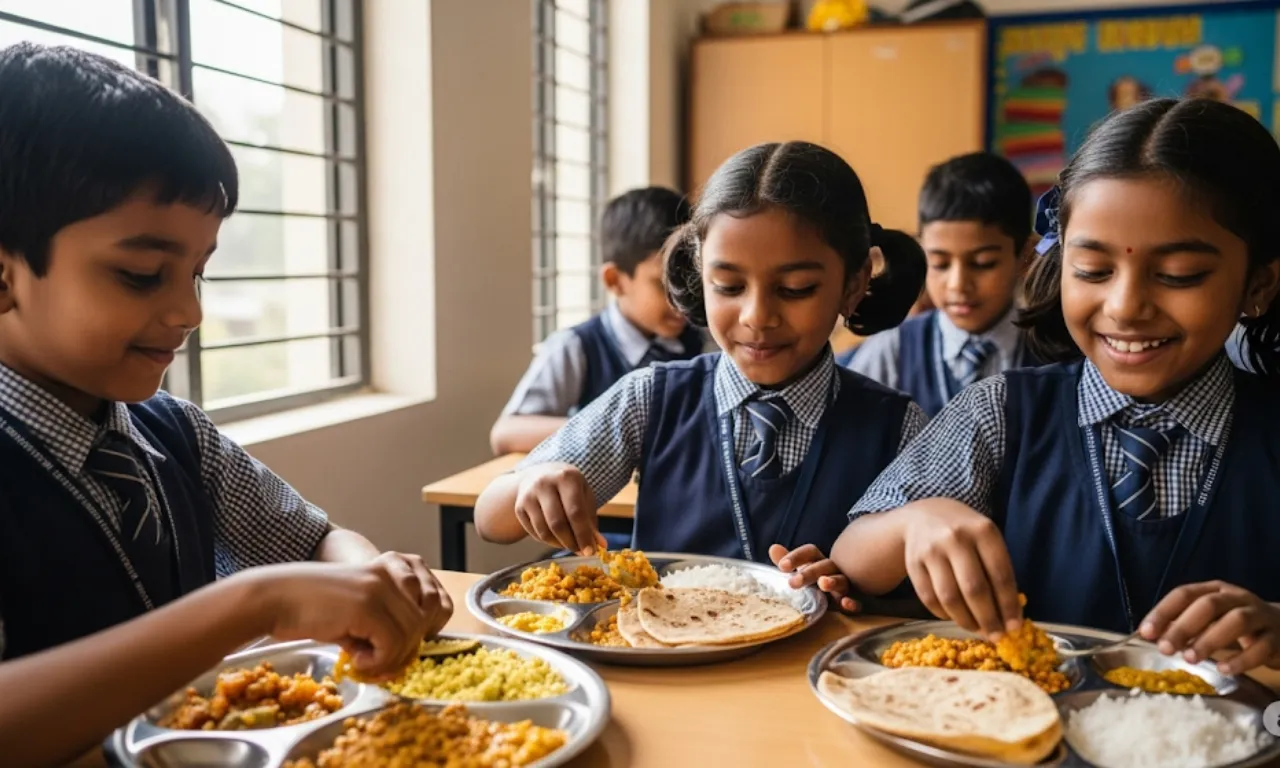- PM POSHAN Scheme provides hot, nutritious meals to about 11 crore children in over 10.35 lakh schools across the country.
- More than 24 lakh Cook-cum-Helpers, with over 90% women, prepare meals while maintaining quality and hygiene.
- Budget allocations of around Rs 12,500 crore, along with flexible funds, support nutrition gardens and extra food initiatives for better health benefits.
PM POSHAN Shakti Nirman Scheme remains an important government program, offering hot, nutritious meals to nearly 11 crore children in more than 10.35 lakh schools. This key scheme helps improve children’s nutrition and encourages regular attendance in government and aided schools.
How Far the PM POSHAN Scheme Reaches in India
PM POSHAN Scheme covers 11 crore children studying in government and government-aided schools all over India. These meals are served in over 10.35 lakh schools, making it one of the biggest nutrition programs in the country.
Who Benefits: Bal Vatika and Classes I to VIII
The scheme focuses on different groups of students, especially children in Bal Vatika (pre-primary) and those in classes I through VIII. The latest numbers show the scheme serves:
- About 29.22 lakh students in Bal Vatika.
- More than 6.58 crore students in classes I to V.
- Around 4.12 crore students in classes VI to VIII.
This wide coverage makes sure children get nutritious meals during their important learning years.
Also Read – PMAY Beneficiary List 2025: जानें कैसे प्राप्त करें ₹1.2 लाख की सहायता!
Nutrition Benefits and Boosting School Attendance
The scheme plays a key role in giving growing children the right nutrition, which helps prevent malnutrition and related health problems. By providing at least one hot, healthy meal every day, PM POSHAN encourages better school attendance and supports learning by improving focus and energy.
Financial Support and How Resources Are Used in PM POSHAN
Strong financial support helps the scheme reach millions. The Budget Estimates for FY26 are around Rs 12,500 crore, which keeps the program running smoothly nationwide.
The Role and Support of Cook-cum-Helpers (CCHs)
More than 24 lakh Cook-cum-Helpers are the backbone of the scheme, preparing and serving meals with care. Impressively, over 90% of these helpers are women, promoting women’s participation and support within local communities.
Building Infrastructure: Kitchen-cum-Stores (KCS) Status
Infrastructure has been given high priority, with 9.11 lakh Kitchen-cum-Stores built out of the approved 9.41 lakh units. This ensures hygienic food preparation and proper storage at schools, improving meal quality and safety.
Flexible Budget and Extra Nutrition Programs
The scheme includes a flexible budget component, about 5% of the recurring budget, which states and UTs can use as needed. Common uses include setting up School Nutrition Gardens to grow fresh vegetables and fruits, and providing extra food items like chikki, eggs, milk, and fruits in selected districts to increase dietary variety and nutrition. Right now, more than 6.28 lakh schools have their own nutrition gardens, showing community involvement and a move towards overall child health.
| Parameter | Value |
|---|---|
| Number of Children Covered | About 11 crore |
| Number of Schools Covered | More than 10.35 lakh |
| Budget Estimate | Rs 12,500 crore |
| Foodgrains Supplied | 26 lakh metric tonnes (100% free by Government) |
| Material Cost Increase | 9.50% (from May 1, FY26) |
| Cook-cum-Helpers Engaged | Over 24 lakh (90% women) |
| Kitchen-cum-Stores Constructed | 9.11 lakh (97% of approved) |
| Schools with Nutrition Gardens | More than 6.28 lakh |
If you’re a parent, guardian, teacher, or community member, knowing about the Pradhan Mantri Poshan Shakti Nirman Scheme can help you see the government’s effort to improve children’s health and education in India. It’s a great example of how working together can create a healthier, better-educated next generation.

